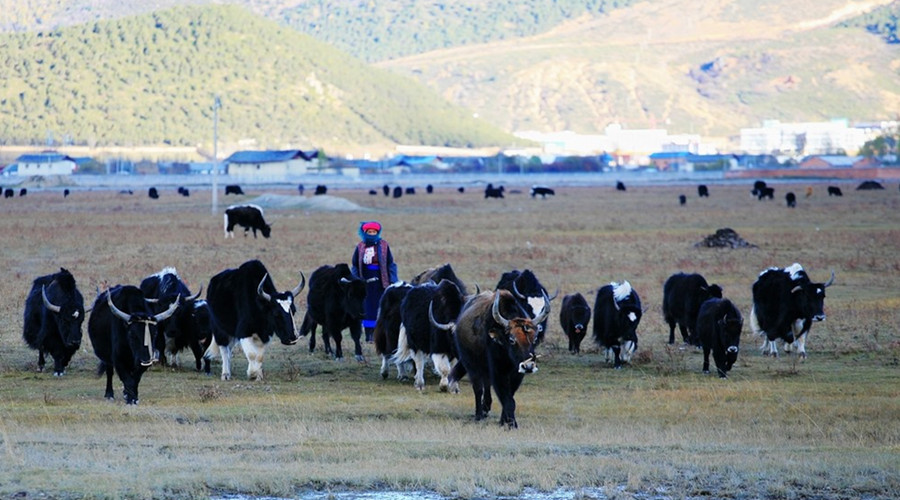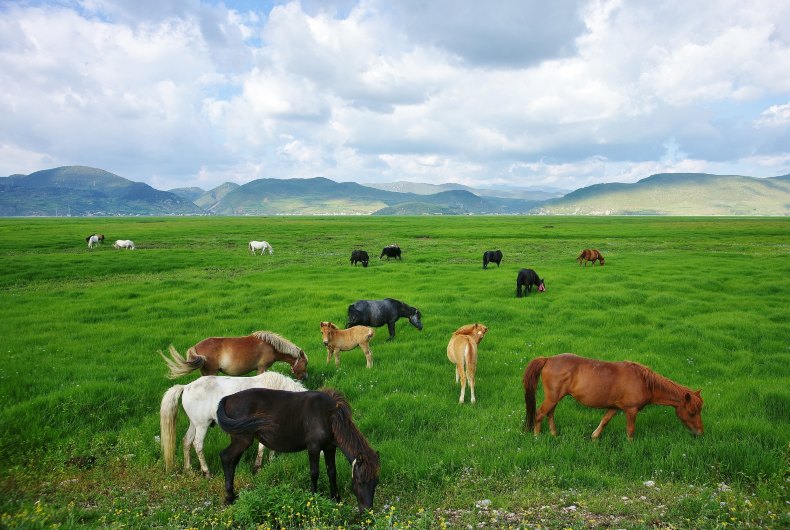
Napahai Lake Birding Travel Tips in Shangrila
Napa Lake, like many wetlands across China, has undergone a transformation from pristine forests and vast bodies of water to increased agricultural land through drainage, winter pastures, and significant reduction in forested areas. This has led to decreased water retention capacity and triggered flooding disasters. Additionally, scars left on surrounding mountains from sand and gravel extraction serve as reminders of environmental destruction, prompting reflections on conservation efforts.
In the late 1990s, initiatives such as natural forest protection and returning farmland to forests began around Napa Lake, gradually allowing vegetation on surrounding mountains to recover.
The history of Napa Lake is vividly portrayed in the text and photographs of the book “Birds of Napa Lake” by teachers Han Lianxian and Peng Jiansheng. Han Lianxian recalls his first visit in December 1984, describing Zhongdian (before it was renamed Shangri-La) and Napa Lake as desolate, remote, and harsh in climate. By winter 1988, the population of black-necked cranes in China had dwindled to 2,000 individuals, classified as endangered. Over three days, observations were made on the crane population, adult and young ratios, and the slow growth observed due to protection efforts over the years.
In spring 2002, Shangri-La County proposed packaging Napa Lake, Bitahai Lake, and Shudu Lake for a national-level natural reserve, prompting surveys on birds and mammals in these areas. The wintering population of black-necked cranes at Napa Lake had grown to around 250 individuals.
Post-2005, under local government commission, Han Lianxian led scientific research and collaborated with local governments and non-governmental organizations to train local residents in bird conservation, bird-watching, and ecotourism, benefiting from the rapid tourism development in Shangri-La.
However, challenges remain with the aftermath of natural disasters caused by environmental degradation, such as the summer floods of 2002 that submerged National Highway 214. To ensure road access, the transportation department temporarily elevated road embankments. With assistance from local environmental organizations like Shambhala Manor and the county government, Napa Village purchased rubber and metal boats to address transportation issues.
While natural forest protection and reforestation projects initiated in the late 1990s have facilitated the gradual recovery of mountain vegetation around Napa Lake, the process to fully restore the original ecological balance will require considerable time due to its high altitude, long winters, and slow plant growth.
Bird Situation at Napa Lake in Winter
Napa Lake was designated as a natural reserve for wintering Black-necked Cranes by the Yunnan Provincial Government in 1983, subsequently upgraded to a provincial-level protected area, and approved as an internationally important wetland in 2004.
Napa Lake is a seasonal plateau lake, expansive in summer but rapidly drying in winter. For instance, the winter water area decreased from 1,300 hectares in 2007-2008 to 600 hectares. Research over the past 30 years by scholars like Mr. Han has consistently shown that waterfowl dominate the wintering bird population at Napa Lake. Early winter sees the highest diversity and abundance, with over 50 species and more than 20,000 water birds. As winter progresses and the water body shrinks, both the variety and number of water birds decrease. By late winter, the species count is about half of early winter, and the numbers are about a third. Moreover, thanks to years of conservation efforts, the population of Black-necked Cranes shows a steady and slow increase, with over 300 cranes wintering at Napa Lake annually.
Napa Lake is surrounded on three sides by mountains and opens towards the Zhongdian Basin, with forests, meadows, swamps, lakes, farmland, and villages nestled amidst the backdrop of blue skies, white clouds, and snow-capped mountains. Positioned along the migratory pathway of western Chinese birds, it is an ideal wintering ground for migratory birds. In early December 2016, a national synchronized waterfowl survey coordinator meeting was held at Napa Lake, where representatives conducted a two-day survey around the lake from the 6th to the 7th, recording over 37 species and more than 30,000 water birds. Among them, the Bar-headed Goose accounted for nearly half, and abundant species included the Red-crested Pochard, Bar-headed Goose, and Common Pochard. Notably recorded were over 280 Black-necked Cranes, 230 Black Storks, 40 White-tailed Eagles, and 1 Crested Serpent Eagle.
In addition to synchronized bird counts around the lake, visits to the alpine botanical gardens on the lake’s highlands and serene villages along its shores are essential. Each village around Napa Lake has its sacred mountain, motivating local residents to voluntarily protect the wildlife and plants in these mountains, reflecting the profound folk and religious culture of the Tibetan area.
Key bird species at Napa Lake:
- 黑颈鹤 (Black-necked Crane)
- 白尾海雕 (White-tailed Sea Eagle)
- 斑翅朱雀 (Varied Tit)
- 滇鳾 (Yunnan Nuthatch)
- 棕胸岩鷚 (Rock Bunting)
- 灰头灰雀 (Grey-headed Bullfinch)
- 普通秋莎鸭 (Common Pochard)
- 栗耳鹀 (Chestnut-eared Bunting)
- 渡鸦 (Raven)
- 棕头鸥 (Brown-headed Gull)
- 宝兴鹛雀 (Baoshan Jay)
- 黑鹳 (Black Stork)
- 凤头麦鸡 (Blood Pheasant)
- 煤山雀 (Coal Tit)
- 高山雀鹛 (Alpine Accentor)
- 栗臀䴓 (Chestnut-flanked White-eye)
- 斑头雁 (Bar-headed Goose)
- 赤麻鸭 (Ferruginous Duck)
- 红眉朱雀 (Red-browed Finch)
- 白喉红尾鸲 (White-throated Redstart)
- 白眉雀鹛 (White-browed Laughingthrush)
Bird Watching Guide: Viewing Points, Transportation, Accommodation
Napa Lake is situated at an altitude of approximately 3,200 meters, about 8 kilometers northwest of Zhongdian County (Shangri-La), and approximately 22 kilometers from Shangri-La Airport. The circular route around the lake spans about 40 kilometers, accessible by car or bicycle. Some smaller roads lead to private estates, so it’s advisable to seek permission before driving.
Special Reminder: Avoid venturing onto small paths extending into the lake area to prevent getting stuck. For many years, Xiangbala Manor has been a base for bird experts and enthusiasts, offering convenient lodging, car rentals, and airport transfers by prior appointment.
There are 6 excellent observation points around the circular route of Napa Lake:
- Towards Alpine Botanical Garden: Pass through Chuizongdala and Napa Lake Wetland Park along the road from the county town. This area offers the closest proximity to shallow water for observing and photographing Black Storks.
- Alpine Botanical Garden: Bird activity is best in the morning. Ticket sales start at 8 am; visitors can enter early by opening the iron gate and pay upon departure around noon. There are numerous pheasants inside and around the botanical garden, particularly near the office building, medicinal plant garden, and near the broken wall adjacent to the highway. The large parking lot outside the botanical garden provides a comprehensive view of the northern section of Napa Lake. Next to the parking lot, a small door leads down steps to observe birds in shrub habitats; the Wallcreeper and Baoshan Jay are commonly seen here.
- Towards Xiangbala Manor from Alpine Botanical Garden: Follow the lake route towards the northwest corner near Lalong Village. Take a small path into the village, passing through houses and farmland. The birdwatching along the dirt road is excellent, with highlights including Meadow Buntings, Rufous-vented Tits, Yunnan Nuthatches, Striated Prinias, and White-throated Redstarts. The White-tailed Sea Eagle prefers resting on large trees along steep mountain slopes.
- Around Napa Village: There are plenty of field birds around Napa Village, with close proximity to waterfowl along the lake. A stroll after meals can yield significant sightings.
- Towards Bren and Naqu River in the East: Head south from Xiangbala Manor along the circular route towards Bren and Naqu River. This area features extensive marshes and grasslands, favored by large raptors for resting.
- Facing “Darige” Hill Across from Xiangbala Manor: Located in front of Xiangbala Manor, “Darige” Hill offers a higher elevation. Drive from the village road to the foothill and climb to a large platform on the summit. This spot provides a panoramic view of the central section of Napa Lake.

 7 Days GolfingTour
7 Days GolfingTour
 8 Days Group Tour
8 Days Group Tour
 8 Days Yunnan Tour
8 Days Yunnan Tour
 7 Days Shangri La Hiking
7 Days Shangri La Hiking
 11 Days Yunnan Tour
11 Days Yunnan Tour
 6 Days Yuanyang Terraces
6 Days Yuanyang Terraces
 11 Days Yunnan Tour
11 Days Yunnan Tour
 8 Days South Yunnan
8 Days South Yunnan
 7 Days Tea Tour
7 Days Tea Tour
 8 Days Muslim Tour
8 Days Muslim Tour
 12 Days Self-Driving
12 Days Self-Driving
 4 Days Haba Climbing
4 Days Haba Climbing
 Tiger Leaping Gorge
Tiger Leaping Gorge
 Stone Forest
Stone Forest
 Yunnan-Tibet
Yunnan-Tibet
 Hani Rice Terraces
Hani Rice Terraces
 Kunming
Kunming
 Lijiang
Lijiang
 Shangri-la
Shangri-la
 Dali
Dali
 XishuangBanna
XishuangBanna
 Honghe
Honghe
 Kunming
Kunming
 Lijiang
Lijiang
 Shangri-la
Shangri-la
 Yuanyang Rice Terraces
Yuanyang Rice Terraces
 Nujiang
Nujiang
 XishuangBanna
XishuangBanna
 Spring City Golf
Spring City Golf
 Snow Mountain Golf
Snow Mountain Golf
 Stone Mountain Golf
Stone Mountain Golf














